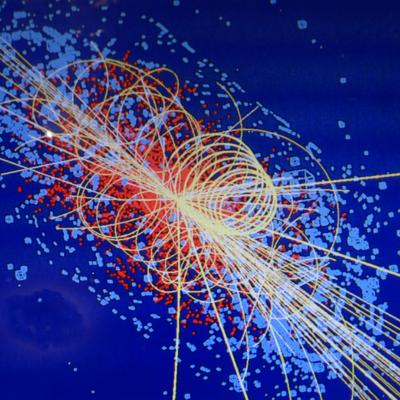Anúncios
The identification of the Higgs boson as a fundamental particle represents one of the most significant milestones in modern physics. This elusive particle, often referred to as the “God particle,” plays a crucial role in our understanding of the universe and the fundamental forces that govern it. The discovery of the Higgs boson not only validates the Standard Model of particle physics but also opens new avenues for research and exploration in the field of high-energy physics.
The journey to identify the Higgs boson involved decades of theoretical predictions and experimental efforts. The particle was first proposed in the 1960s by physicist Peter Higgs and others, who sought to explain how particles acquire mass. It was only on July 4, 2012, that scientists at the Large Hadron Collider (LHC) at CERN announced the discovery of a particle consistent with the Higgs boson. This groundbreaking achievement has sparked a wealth of research aimed at understanding the properties and implications of this fundamental particle.
Anúncios

How the Identification of the Higgs Boson as a Fundamental Particle Works
The identification of the Higgs boson involves complex processes that integrate theoretical predictions with experimental validation. At the heart of this endeavor is the Standard Model of particle physics, which provides a framework for understanding the fundamental particles and forces in the universe. According to this model, the Higgs boson is essential for explaining how particles acquire mass through their interactions with the Higgs field, a pervasive field that permeates the universe.
The experimental identification of the Higgs boson mainly took place at CERN’s LHC, where protons are accelerated to near-light speeds and collided. These high-energy collisions create conditions similar to those that existed shortly after the Big Bang, allowing scientists to investigate the fundamental constituents of matter. When protons collide, they produce a variety of particles, including the Higgs boson, which can decay into other particles almost instantly. Detecting these decay products is crucial for confirming the presence of the Higgs boson.
The process of identifying the Higgs boson is marked by the analysis of large amounts of data generated from particle collisions. Advanced algorithms and computational techniques are employed to filter this data, searching for specific signatures that indicate the presence of the Higgs boson. By comparing experimental results with predictions made by the Standard Model, scientists can determine whether the observed particle aligns with the characteristics of the Higgs boson.
In addition, the identification process is not limited to confirming the existence of the Higgs boson; it also involves measuring its properties, such as mass, spin, and interaction forces. These measurements are critical for testing the validity of the Standard Model and exploring potential physics beyond it. As researchers continue to refine their techniques and collect more data, they seek to uncover deeper insights into the nature of the Higgs boson and its role in the universe.
Advantages of Identifying the Higgs Boson as a Fundamental Particle

Identifying the Higgs boson as a fundamental particle brings numerous advantages that significantly enhance our understanding of the universe. One of the most notable benefits is the validation of the Standard Model of particle physics, which has been the cornerstone of our understanding of fundamental particles and their interactions. The successful identification of the Higgs boson confirms the theoretical framework that has guided physicists for decades, reinforcing the model’s validity and predictions.
Beyond validating the Standard Model, the identification of the Higgs boson opens new avenues for research in particle physics. With the Higgs boson firmly established, scientists can explore its properties and interactions in greater detail. This exploration may lead to the discovery of new physics beyond the Standard Model, such as supersymmetry or other theories that aim to explain phenomena not fully accounted for by current models. The Higgs boson serves as a gateway to understanding these unexplored territories in physics.
Moreover, the implications of the Higgs boson extend beyond particle physics; they also have a profound impact on cosmology and our understanding of the evolution of the universe. The Higgs field is believed to have played a crucial role in the early universe, influencing the distribution of matter and energy. By studying the Higgs boson, researchers can gain insights into the conditions that prevailed during the Big Bang and the subsequent formation of the cosmos.
Finally, the identification of the Higgs boson has far-reaching technological implications. Advances in particle detection techniques and data analysis developed during the search for the Higgs boson have applications in various fields, including medicine, materials science, and information technology. The knowledge gained from this research not only enhances our understanding of the universe but also drives innovation and technological progress across multiple areas.
How to Understand the Identification of the Higgs Boson as a Fundamental Particle
Understanding the identification of the Higgs boson as a fundamental particle involves exploring several key aspects that illuminate its importance in the field of particle physics.
Understanding the role of the Higgs boson in mass generation:
The Higgs boson is intrinsically linked to the Higgs field, which gives mass to elementary particles through the Higgs mechanism. This process explains why some particles, like the W and Z bosons, are massive, while others, like photons, remain massless.
Exploring the importance of the Large Hadron Collider in the Higgs discovery:
The LHC is the world’s largest and most powerful particle accelerator, designed to collide protons at unprecedented energy levels. This facility was essential for creating the conditions needed for the production of the Higgs boson, allowing scientists to study its properties.
Learning about the relationship between the Higgs boson and the Standard Model of particle physics:
The Higgs boson is a critical component of the Standard Model, which describes the fundamental particles and forces in the universe. Its discovery confirms the model’s predictions and strengthens our understanding of particle interactions.
Examining the implications of the Higgs boson for quantum field theory:
The Higgs boson provides insights into the nature of quantum fields and their interactions. Its existence supports the framework of quantum field theory, which underpins much of modern physics.
Discovering the impact of the Higgs boson on the weak force:
The Higgs boson plays a vital role in the weak nuclear force, one of the four fundamental forces of nature. Its interactions with other particles are crucial for understanding processes such as beta decay and neutrino interactions.
Investigating ongoing research related to the Higgs boson:

The discovery of the Higgs boson is just the beginning. Ongoing research aims to explore its properties, search for potential new particles, and investigate phenomena that challenge the Standard Model, such as dark matter and dark energy.
As scientists continue to unravel the mysteries surrounding the Higgs boson, they not only deepen our understanding of the fundamental nature of the universe but also pave the way for future discoveries that may revolutionize our understanding of physics.
The Role of the Higgs Boson in the Universe
The Higgs boson is essential for explaining the mass of elementary particles. It interacts with these particles through the Higgs field, allowing them to acquire mass. Without it, the universe as we know it would not exist.
This selective interaction helps explain why some particles have mass and others do not. For example, photons do not interact with the Higgs field, remaining massless. On the other hand, the W and Z bosons interact strongly and are heavy.
The Higgs field is present throughout the universe like an invisible mesh. Particles move through it, and the resistance they encounter is what we interpret as mass. This revolutionizes our understanding of matter.
Therefore, the Higgs boson is a key to unlocking the hidden architecture of the cosmos. By understanding it, we come closer to the most fundamental laws of nature. Its importance goes beyond particle physics.
The Path to Discovery at the LHC
The discovery of the Higgs boson required decades of theoretical and experimental work. Since its proposal in the 1960s, scientists sought to confirm its existence. This journey culminated with the Large Hadron Collider.
The LHC enabled the simulation of conditions close to those of the Big Bang. By colliding protons at extremely high energies, it generated rare particles, among them the long-sought Higgs boson. Detecting its traces required cutting-edge technology.
Thousands of scientists analyzed trillions of collisions in search of consistent signals. Confirmation came in 2012 with the identification of a particle whose characteristics matched those predicted. It was a historic milestone.
This process demonstrated the power of collaborative science. The LHC discovery united efforts from physicists, engineers, and mathematicians. The success confirmed the robustness of the theories behind the Standard Model.
Did You Enjoy Learning About the Identification of the Higgs Boson as a Fundamental Particle?
The identification of the Higgs boson as a fundamental particle is a fascinating journey through the realms of theoretical and experimental physics. It highlights the intricate relationship between fundamental particles and the forces that govern their behavior. As researchers continue to explore the implications of this discovery, our understanding of the universe is bound to evolve further.
If you are intrigued by the complexities of particle physics and the role of the Higgs boson, there is much more to discover. Ongoing research and advances in this field promise to reveal new insights that will deepen our appreciation for the universe and its fundamental workings.
Frequently Asked Questions
What is the Higgs boson?
The Higgs boson is a fundamental particle. It gives mass to other particles.
Why is the identification of the Higgs boson important?
The identification of the Higgs boson as a fundamental particle helps us understand the universe. It confirms parts of the Standard Model of physics.
How did scientists identify the Higgs boson?
Scientists used the Large Hadron Collider. They detected the particle by colliding protons at high energies.
What would happen if the Higgs boson didn’t exist?
If the Higgs boson didn’t exist, particles would have no mass. The universe would be a very different place.
Where can we see the results of the identification of the Higgs boson?
The results are available in scientific studies. Many universities and organizations share this information online.
